Innovative Drip Irrigation Systems for Modern Agriculture
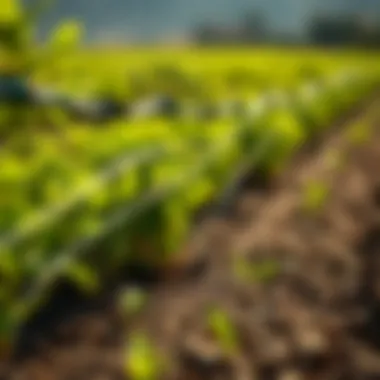

Intro
In the world of agriculture, where the demand for sustainable practices has never been more pressing, drip irrigation systems have emerged as a shining beacon of innovation. As farmers face the dual challenge of maximizing yields while conserving precious water resources, the spotlight falls on these advanced irrigation methods. Unlike traditional irrigation systems that waste a significant amount of water through evaporation and runoff, drip irrigation delivers water directly to the root zone of plants. This method not only improves water efficiency but also has profound implications for crop health and productivity.
Stay tuned as we embark on a thorough exploration of these innovative systems, dissecting their mechanics, discussing their benefits, and highlighting the challenges they present. Our journey will involve an in-depth look at the latest advancements in technology and materials that are reshaping the agricultural landscape. By the end, you will gain a comprehensive understanding of how drip irrigation systems can revolutionize contemporary farming practices.
Preface to Drip Irrigation
Drip irrigation represents a transformative shift in agricultural practices, effectively addressing the pressing demand for improved water management across the globe. In an era where agricultural productivity is crucial to feeding a growing population, it is essential to deeply understand this irrigation method’s mechanics, benefits, and challenges. The purpose of this section is not merely to introduce drip irrigation but to lay the groundwork for why this topic merits attention from farmers and agricultural enthusiasts alike.
Overview of Irrigation Techniques
Irrigation techniques can be broadly categorized into several methods, each tailored to specific crop needs and regional conditions. Traditional surface irrigation, for instance, often leads to significant water loss through evaporation and runoff. Meanwhile, sprinkler systems, while offering better distribution than surface methods, still experience considerable inefficiencies.
In contrast, drip irrigation stands out due to its precision. This method delivers water directly to the plant roots in the form of small droplets, thus minimizing waste. To illustrate, consider the difference between watering a garden with a traditional hose, leading to uneven wetness and possibly overwatering in certain areas, versus utilizing a drip system that ensures each plant receives only what it needs.
Some notable irrigation techniques include:
- Surface Irrigation: Utilizes gravity to distribute water, commonly seen in rice paddies.
- Sprinkler Systems: Mimics rainfall; best for flat lands but can waste resources.
- Subsurface Irrigation: Delivers water below the surface, reducing evaporation but requiring complex installation.
- Drip Irrigation: Targets individual plants, conserving water and focusing on delivering nutrients effectively.
These varied methods highlight the importance of choosing the correct system, as the efficiency of water utiliztion is directly tied to agricultural success.
Importance of Water Management in Agriculture
Water management is not just a choice in farming; it’s a necessity. The increasing unpredictability of weather patterns due to climate change makes sound water management practices more important than ever. Consider that agriculture accounts for almost 70% of global freshwater withdrawals. This statistic underscores the urgency for methods that enhance water efficiency.
Drip irrigation systems are a prime example of how optimized water management can yield several advantages:
- Conservation of Water: Direct application to the root zone reduces waste.
- Improved Crop Health: Water stress on plants is mitigated, leading to stronger yields.
- Enhanced Sustainability: Less water use means less impact on local water sources, allowing ecosystems to thrive.
- Adaptability: Drip systems can be adjusted based on soil moisture monitors, ensuring optimal conditions even amid fluctuations in weather.
"In agriculture, wise water management can make the difference between failure and success."
By embracing advanced systems like drip irrigation, farmers can not only safeguard their crops and livelihoods but also contribute to a more sustainable future for agriculture. In summary, understanding drip irrigation and its context within broader agricultural practices is crucial as we navigate the challenges posed by an ever-changing environment.
What is a Drip Irrigation System?
Drip irrigation systems represent a significant evolution in the pursuit of efficient water use in agriculture. Unlike traditional irrigation methods that may lead to excessive runoff or evaporation, drip systems deliver water directly to the plant’s root zone. This precision not only reduces water waste but also optimizes the growth conditions for crops. Understanding drip irrigation is fundamental for any agricultural professional or enthusiast looking to modernize farming practices and encourage sustainability.
Components of a Drip System
At the heart of a drip irrigation system are several key components that work together to ensure efficient water delivery:
- Mainline/Control Valve: This component regulates the flow of water from the source to the system. It’s designed to maintain appropriate pressure levels, ensuring that water distributes evenly.
- Sub-main and Lateral Lines: Made from durable materials, these pipes carry water from the mainline to the individual emitters near the plants. The design and material of these lines can affect system longevity and performance greatly.
- Emitters: These are crucial devices that release water at a controlled rate. They can be pre-installed in the mainline or added separately, depending on the design of the system. Emitters can be adjustable, allowing customization for specific crop needs.
- Filters: To protect the system from clogging, filters remove debris and particles from the water. Regular maintenance is vital to keep these filters functioning well.
- Pressure Regulators: These ensure that water enters the system with the right pressure, preventing undue stress on the emitters and components.
Each of these elements works in harmony to create a sustainable and highly efficient irrigation environment.
Types of Drip Irrigation
When it comes to drip irrigation, there are several types, each suited for specific agricultural needs and conditions.
Surface Drip Systems
Surface drip systems release water on the soil surface, allowing for easy absorption into the ground. A notable advantage is that they facilitate quick adjustments to how and when water is delivered to crops. Farmers appreciate this system for its flexibility — it can be installed in both large fields and smaller garden plots. The ease of setting up this type of system makes it a popular choice for many farmers looking to upgrade their methods. However, the downside can be potential evaporation losses in hotter climates, which can limit efficiency.
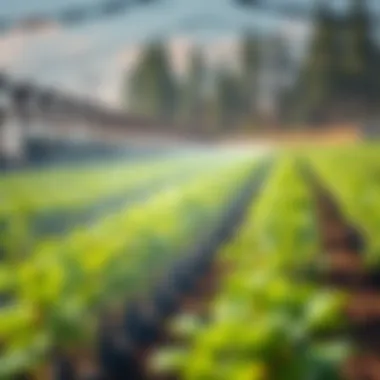
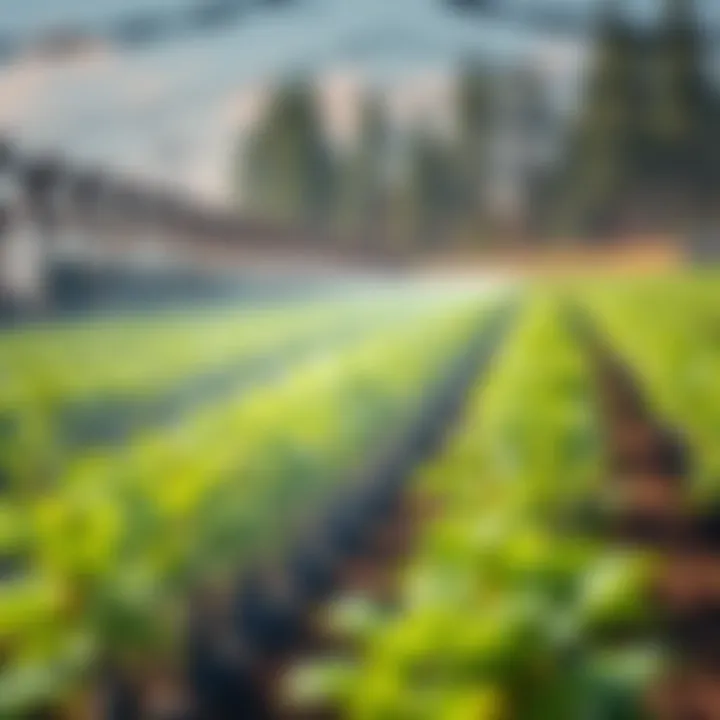
Subsurface Drip Systems
Subsurface drip systems take water delivery underground, with lines buried beneath the soil surface. This design minimizes evaporation and helps prevent weed growth, as water is only available to plant roots. Its key characteristic is reducing surface runoff while maintaining optimum soil moisture. However, it does come with its own set of challenges, including higher installation costs and potential difficulties with maintenance and repairs. Choosing subsurface systems often depends on crop type and soil conditions; well-drained soils are typically preferred.
On-Demand Drip Systems
With on-demand drip systems, water is delivered only when necessary, based on soil moisture levels monitored by sensors or manual observation. This responsive nature can lead to significant water conservation, making it an enviable option in regions facing water scarcity. The main benefit here is the ability to gauge real-time conditions, allowing farmers to respond to weather changes swiftly. However, it requires some initial investment into technology, which can be a barrier for some.
"Drip irrigation is not just about saving water; it's about creating a sustainable future for agriculture."
The variety in drip irrigation design ensures that farmers can find a system that fits their landscape and watering needs. By understanding the components and types of systems available, professionals in agriculture can make informed choices that align with both productivity and sustainability goals.
Advantages of New Drip Irrigation Systems
In recent years, drip irrigation systems have significantly evolved, making them more efficient and effective for agricultural practices. These innovations not only improve water usage but also support sustainable farming. The benefits are numerous, and understanding them can help farmers make informed decisions about their irrigation methods. Below, we cover several key advantages that come with implementing modern drip irrigation systems.
Water Efficiency Benefits
One of the most significant advantages of new drip irrigation systems is their remarkable efficiency in water usage. Traditional irrigation methods can lead to excessive water waste through runoff and evaporation, but drip systems deliver water directly to the plant roots. This targeted watering significantly reduces the amount of water unnecessary for irrigation.
- Targeting: With a drip system, the water goes exactly where it is needed, ensuring plants receive just the right amount.
- Lower Consumption: Many farmers report cut-downs in water usage by up to 50% compared to conventional methods. This can be a game-changer in regions facing water scarcity.
- Drought Resilience: Such systems help crops withstand dry spells more effectively than their flood-irrigated counterparts, making them an asset in an era increasingly characterized by climate unpredictability.
"Efficient water use isn't just about saving money; it's also about preserving the environment for future generations."
Enhanced Crop Yields
Enhanced crop yields are another significant plus when using modern drip irrigation systems. By ensuring that crops receive optimal water levels, farmers can cultivate healthier plants that yield more produce. This increased productivity often leads to better economic returns.
- Root Health: The controlled environment provided by drip systems helps avoid over-saturation, which can lead to root rot. Instead, plants thrive and develop deep, healthy roots.
- Consistency: With consistent watering, farmers are likely to produce more uniform crops, both in size and quality. This predictability can boost profit margins, especially in markets where appearance counts.
- Adaptation: Many new systems allow for adjustments in fertilizer application, enhancing nutrient delivery alongside water, which further augments growth.
Reduction of Weed Growth
Another often-overlooked advantage of modern drip irrigation systems is their role in controlling weed growth. By minimizing water availability to unintended plants, farmers can maintain more focus on their crops without spending excessive time and resources on weed control.
- Less Competition: Weeds thrive in saturated soils. With drip irrigation's targeted approach, surrounding weeds often remain starved for nutrients and moisture.
- Reduced Herbicide Use: The decrease in weed growth means that farmers can limit herbicide applications, which is beneficial for both the environment and consumer health.
- Labor Costs: Reduced weed presence can lead to lower labor costs associated with weeding, allowing farmers to redirect efforts towards more essential tasks.
In light of the challenges surrounding water scarcity and sustainable farming, the advantages of innovative drip irrigation systems are clearer than ever. Understanding these benefits is crucial for anyone involved in agriculture, whether they be established farmers or enthusiastic newcomers.
Challenges in Implementing Drip Irrigation Systems
Drip irrigation systems are heralded for their water efficiency and ability to enhance crop yields. However, the journey to implement these systems is not without its bumps in the road. This section will explore fundamental challenges that often surface when introducing drip irrigation in agricultural practices, focusing on cost implications and maintenance issues. It's indispensable for farmers and agricultural enthusiasts to understand these hurdles for better planning and investment.
Cost Implications
The financial aspect is often the first consideration for farmers when contemplating drip irrigation. While the long-term benefits can be substantial, the initial investment can cause sticker shock. Drip systems often require a hefty upfront cost due to the specialized components needed such as pipes, emitters, and pressure regulators. Moreover, the installation of these systems is not a simple task; it can demand specialized labor and expertise, which further escalates expenses.
- The average cost of a drip irrigation system can range significantly, frequently hitting thousands of dollars per acre. Not merely the setup, but additional costs may underpin:
- Soil testing and system design to ensure optimal configuration.
- Water source preparation, which can involve drilling wells or building reservoirs.
- Permitting and regulatory compliance, since some regions demand specific legal approvals.
Furthermore, this financial burden raises questions regarding ROI. A farmer must assess:
- Expected water savings and increased yields.
- Potential reductions in labor costs due to less manual irrigation management.
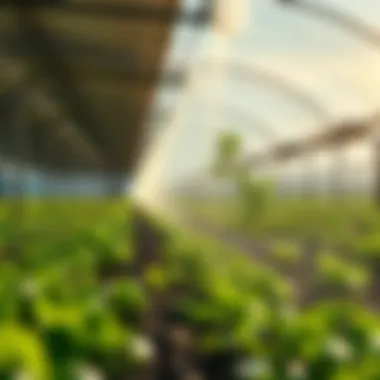
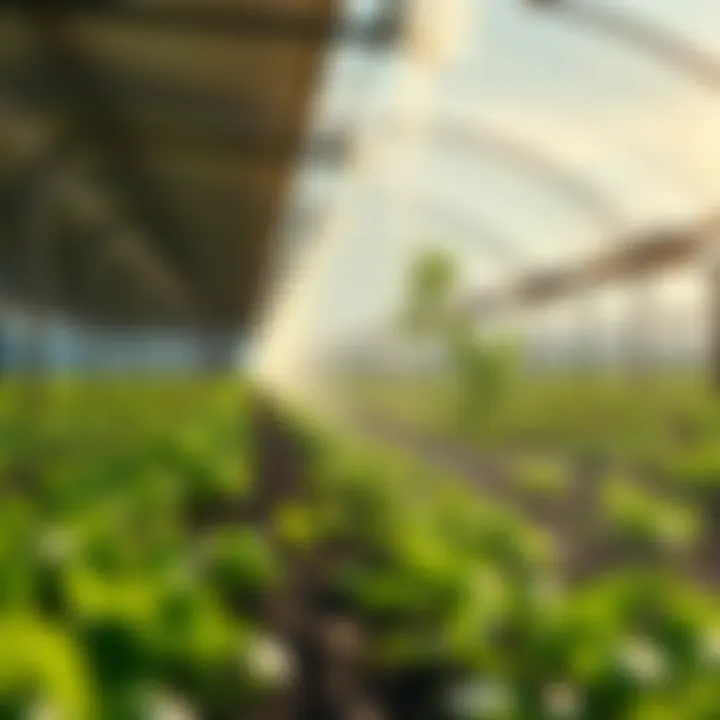
Ultimately, patience is a virtue in this realm. Farmers may not see immediate returns, making the upfront costs a daunting barrier. However, in the grand scheme of sustainable farming, investing in efficient irrigation can mean both financial and ecological gains.
Maintenance and Management Issues
Once in place, a drip irrigation system needs diligent management and maintenance. Neglecting these aspects can lead to significant inefficiencies and potential crop losses. One common issue is clogging; emitters can easily get blocked by sediment or organic material, which can cause uneven water distribution.
- Regular checks are essential to ensure that all components are functioning properly. This includes:
- Inspecting filters and replacing them if necessary.
- Flushing the system to clear out any potential blockages.
Moreover, water pressure is another critical aspect to monitor. Fluctuating pressure levels can compromise the system’s efficiency, leading to either underwatering or overwatering of crops. This requires farmers to maintain proper pressure, often needing a gauge or monitoring that might add another layer of costs.
The management side does not stop at individual systems; it also requires an overarching plan that considers:
- Seasonal changes and how they affect water needs.
- Integration with other farming equipment or methods to ensure seamless operations.
A successful drip irrigation system demands vigilance and planning, making it imperative for farmers to allocate time and resources toward maintaining and managing such systems. Thus, both the costs involved and the operational efforts play a key role in how effectively these systems function.
In every crop, there’s a constant dance—keeping everything in harmony can lead to productive bounties or costly missteps.
Through understanding these challenges, farmers can better prepare themselves for the realities of implementing drip irrigation systems, ultimately paving the way for a more efficient and sustainable agricultural practice.
Technological Innovations in Drip Systems
In the realm of modern agriculture, technological innovations in drip systems are shaping the future of how water is conserved and crops are nurtured. These advancements not only aim to reduce wastage but also enhance productivity and sustainability. Moreover, as environmental challenges multiply, the significance of adopting these innovations becomes even more imperative. Farmers and agricultural professionals need to recognize that incorporating advanced technologies can lead to a more efficient irrigation framework that stands the test of time and climate shifts.
Smart Irrigation Technology
Smart irrigation systems represent a leap forward in water management. These systems utilize sensors, timers, and weather forecasts to optimize water distribution. By incorporating real-time data, smart systems adjust the amount of water applied based on environmental conditions such as rainfall, temperature, and humidity levels. This proactive approach means that water isn’t just thrown around but is carefully dispensed when and where it is needed.
Benefits of smart irrigation technology include:
- Precision: Water is applied in quantities that match the plants' needs, lessening over-or under-watering issues.
- Cost savings: Reduced water bills and less fertilizer runoff can lead to significant yearly savings.
- Sustainability: Contributes to better resource management by minimizing waste and promoting responsible water use.
A practical example would be systems like the Rachio Smart Sprinkler Controller, which connects to Wi-Fi and can be managed through a smartphone application. It integrates local weather data, ensuring that you never water your parched plants after a good rainstorm.
"The future of irrigation lies in integrating technology that not only conserves water but also bolsters crop health and yield."
Use of Sustainable Materials
Another noteworthy advancement in drip irrigation systems revolves around the use of sustainable materials. Traditional drip systems often employ plastic that may not break down naturally, leading to environmental concerns. However, the shift towards biodegradable and recyclable materials is gaining momentum.
Using sustainable materials brings several considerations into play:
- Environmental Impact: Biodegradable components like those made from plant-based polymers dissolve naturally in the environment, contributing far less to landfill waste.
- Local Resources: Some innovations utilize locally sourced materials which can support regional economies and reduce transportation emissions, adding an extra layer of sustainability to the approach.
Moreover, companies like Neversink Farm are pioneering these concepts by developing drip tape that is bio-based and completely free from harmful chemicals, aligning both agricultural needs and ecological responsibilities.
Overall, technological innovations in drip systems point towards a future where efficiency, productivity, and sustainability walk hand in hand. Embracing these changes isn't just a trend but a requisite response to the pressing challenges facing modern agriculture. For more information, aligning with sources such as Wikipedia and Britannica, can provide deeper insights into current practices and future directions.
Case Studies: Successful Drip Irrigation Projects
Examining real-world implementations of drip irrigation systems helps readers grasp the practical applications and benefits of this technology. Case studies provide clear examples of how innovative techniques in irrigation have transformed agricultural practices in various regions. By showcasing successful projects, the effectiveness of drip systems becomes apparent, demonstrating their capacity to address issues like water scarcity and inefficient farming methods.
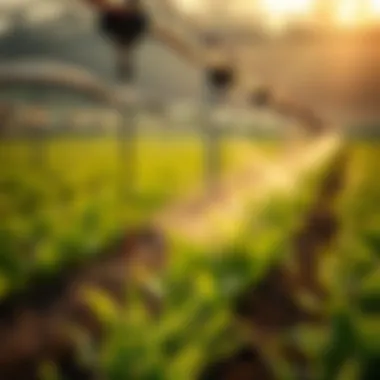
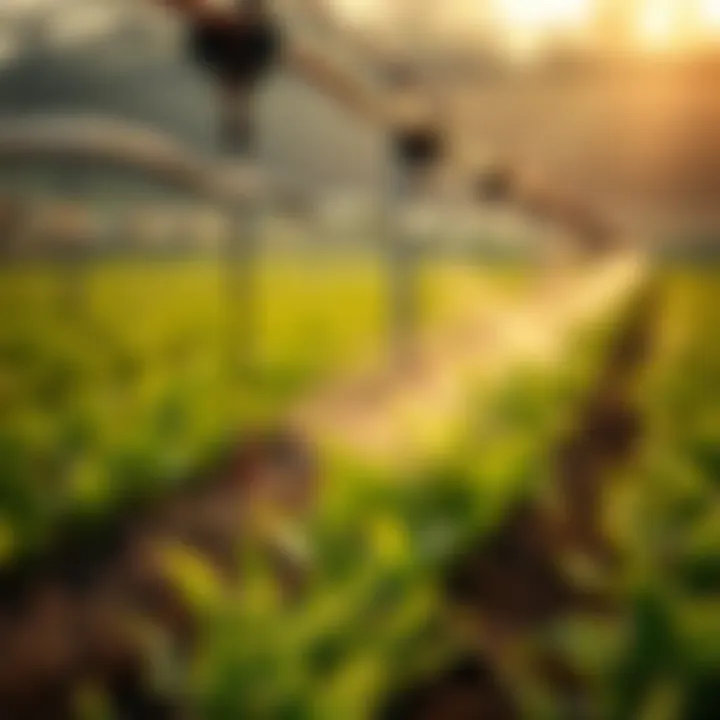
Example from California
In California, a state renowned for its agricultural output, several farms have embraced advanced drip irrigation protocols to cope with persisting drought conditions. One standout project is the collaboration of the University of California with local vineyards in Napa Valley. These vineyards have made the switch from traditional flood irrigation to precision drip systems.
The project was driven by necessity. The annual water allocation had become more stringent, compelling farmers to adopt water-saving technologies. This modernization led to a significant reduction in water usage, estimated at up to 30% while maintaining grape quality.
Farmers also noted enhancements in their production processes. By adopting soil moisture sensors linked to automated drip systems, they could irrigate their crops with pin-point accuracy, depending on actual soil needs. This method not only saves water but also optimizes nutrient use, leading to healthier plants and larger yields. The key takeaway from this Californian project is evident: aspiring to high efficiency and productivity isn't merely theoretical; it can transform operational practices dramatically.
"The drip system has reshaped our approach to farming, proving that sustainability and high yield can walk hand in hand." - Napa Valley Vineyard Owner
Innovations in Israel
Israel stands out globally as a pioneer in innovative agricultural methodologies, particularly when it comes to drip irrigation. The country's unique climate, characterized by arid conditions, compelled it to seek effective water conservation strategies. One remarkable example is the development of the Netafim drip irrigation system, which was founded in the 1960s by farmers seeking better irrigation methods.
The innovative design of these systems allows water to drip directly onto the soil, minimizing evaporation and run-off. In farms across the Negev Desert, for instance, extensively tested pilot projects have shown how this technology can enable extensive crop growth in otherwise inhospitable conditions. Farmers cultivate everything from desert melons to tomatoes, considerably improving yield in an area traditionally deemed unsuitable for agriculture.
What further sets Israel apart is its continual investment in developing advanced technologies, like sensor-driven systems, which monitor conditions and adjust water delivery in real-time, tailoring irrigation to specific plant needs. This adaptability exemplifies the exact blend of innovation and necessity that typically fuels effective agricultural practices. For those looking to understand the broader impact of drip irrigation, Israel's adoption reveals invaluable lessons in functionality and sustainability.
In summary, studying these successful global case studies illustrates the tangible benefits of drip irrigation systems. They not only bolster crop yields and conserve valuable water resources but also serve as a blueprint for integrating technology in sustainable agriculture.
Future Trends in Drip Irrigation
As we wade deeper into the 21st century, the agricultural landscape is undergoing rapid transformations driven by technological advancements and environmental challenges. This section focuses on the future trends shaping drip irrigation systems—the cornerstone of modern, sustainable agricultural practices. With water scarcity growing globally, farmers are increasingly turning to innovative methods like drip irrigation to optimize efficiency. Understanding these trends is not just beneficial but essential for anyone invested in the farming sector.
Impact of Climate Change
Climate change poses significant threats to agricultural productivity worldwide. Variations in precipitation patterns, rising temperatures, and increased frequency of extreme weather events directly affects crop viability and water availability. Drip irrigation, with its precision and efficiency, stands out as a viable response to these challenges. By delivering water directly to the roots, it significantly reduces evaporation and runoff, ensuring that every drop counts.
For farmers, this means:
- Adaptability: Systems can be adjusted to provide different water quantities according to seasonal needs and climatic conditions.
- Drought Resilience: In areas prone to drought, consistent delivery reduces the risk of crop failure. Even during dry spells, crops maintain optimal moisture levels with the right irrigation setup.
- Sustainability: Climate-conscious farmers can reduce their carbon footprint by using energy-efficient pumps and solar-powered irrigation systems. Smart technology can also allow farmers to monitor and adjust water application in real-time based on weather forecasts.
"Effective water management has never been more crucial. As climate patterns shift, adopting advanced systems like drip irrigation may just be the lifeline farmers need."
Integration with Precision Agriculture
The synergy between drip irrigation and precision agriculture is paving the way for a more data-driven approach to farming. Precision agriculture utilizes technology to ensure maximum efficiency, and when combined with drip irrigation, it creates an advanced paradigm for managing resources.
- Data Analytics: Collecting and analyzing data from soil moisture sensors can guide the precise application of water, allowing farmers to tailor their irrigation methods for individual crops. This not only conserves water but can boost yields and reduce costs as well.
- Automation: Automated drip systems can adjust flow rates based on real-time information regarding weather, soil conditions, and plant water needs. This level of control minimizes water waste and enhances plant health.
- Geospatial Technology: Farmers can leverage GIS (Geographic Information Systems) to visualize irrigation patterns and assess field variability. This helps in drafting more efficient irrigation maps, optimizing water distribution further.
Integrating drip irrigation with precision agriculture is akin to steering a ship with a radar. It ensures that the resources used are aligned to the needs of the crops, maximizing productivity while conserving essential water supplies.
The End and Recommendations
In closing, the journey through innovative drip irrigation systems illuminates a pathway for sustainable agricultural practices. The significance of drip irrigation cannot be overstated as it emerges as a practical solution to the pressing issues of water scarcity and inefficiency in traditional farming approaches. While most conventional methods tend to waste water and promote uneven crop growth, drip systems offer precision, delivering water directly to the roots of plants, enhancing growth while conserving water.
Summary of Key Points
Drip irrigation systems present several benefits that stand out:
- Water Conservation: Drip systems can reduce water usage by up to 60% compared to traditional irrigation methods. This efficiency is paramount in regions facing acute water shortages.
- Improved Crop Yield: By providing a steady supply of moisture at the right times, crops are less susceptible to stress, leading to healthier plants and improved harvests.
- Weed Control: Targeting water directly at root zones limits excess moisture that leads to weed growth, fostering more productive farming conditions.
- Environmental Impact: The reduction in water runoff minimizes pollutants entering waterways, promoting a healthier ecosystem.
Best Practices for Implementation
To maximize the benefits of drip irrigation systems, growers should consider the following best practices:
- Conduct a Site Assessment: Evaluate soil types, crop needs, and local climate conditions to design an effective irrigation plan that matches needs.
- Choose Quality Components: Investing in durable hoses, emitters, and filters can enhance the system's lifespan and functionality. Researching brands like Netafim or Rain Bird can be beneficial.
- Regular Maintenance: Frequent checks for clogs, leaks, and pressure issues are essential to ensure operational efficiency. A good rule of thumb is to inspect systems at least once a month during the growing season.
- Integrate Technology: Utilizing smart controllers and moisture sensors helps to automate watering schedules based on current moisture levels, reducing manual labor and ensuring optimal conditions for crops.
- Educate Staff: Ensure everyone involved in the farming process understands the system’s operation. Training on maintenance and troubleshooting can save time and resources in the long run.
By adhering to these recommendations and continuously adapting to new technologies and methods, farmers can significantly enhance their agricultural practices through drip irrigation systems. Staying informed about innovations and leveraging best practices will provide a solid foundation for sustainable farming that is not only efficient but also resilient in the face of changing environmental conditions.
For further insights into drip irrigation techniques, consider visiting resources such as Wikipedia or Britannica. Engage with communities on Reddit to share experiences and gather additional tips on implementing these systems.







